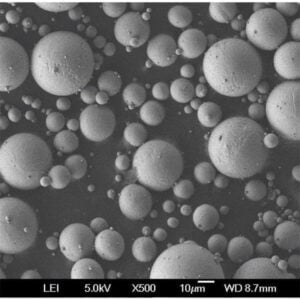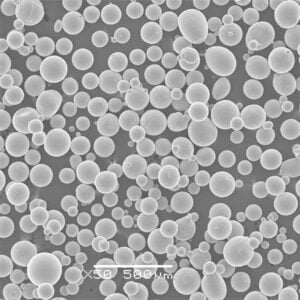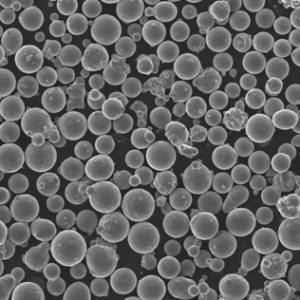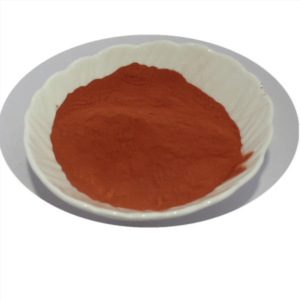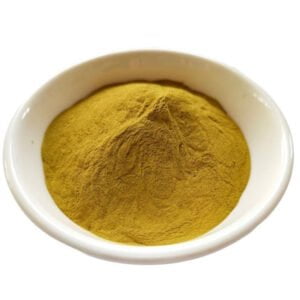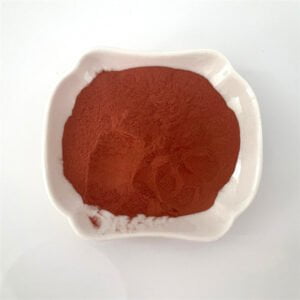티타늄 알루미나이드 분말
목차
티타늄 알루미나이드는 티타늄과 알루미늄으로 구성된 경량, 고강도 금속 간 합금의 한 종류를 말합니다. 이 가이드는 분말 형태의 티타늄 알루미나이드에 대한 참고 자료로서 제조 방법, 조성, 주요 특성 및 매개 변수, 공급업체 및 가격, 산업 전반의 다양한 최종 사용 분야, 자주 묻는 질문 등을 살펴봅니다.
개요 티타늄 알루미나이드 분말
티타늄 알루미나이드 분말은 알루미늄이 다량 함유된 특수 티타늄이 풍부한 합금으로 구성되어 있습니다. 주요 속성:
- 구성: 구성: 티타늄 + 알루미늄 + 기타 원소
- 생산: 미세 분말로 가스 분무
- 입자 모양: 대부분 구형
- 입자 크기: 미크론에서 100미크론까지
- 밀도: 3.7-4.25g/cm3
- 주요 특성: 극한의 내열성 및 내산화성
티타늄과 알루미늄을 혼합하면 기존 합금보다 향상된 특성을 지닌 독특한 경량 결정 구조가 생성되어 최대 ~750°C의 고성능 애플리케이션에서 다양한 용도로 사용할 수 있습니다.
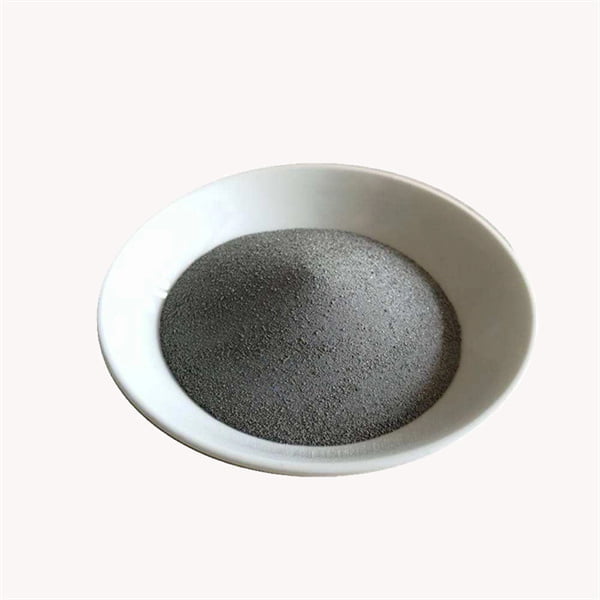
티타늄 알루미나이드 분말의 종류
알루미늄 함량을 조정하고 수식어를 추가함으로써 티타늄 알루미나이드는 특정 미세 구조와 특성을 갖게 됩니다:
| 유형 | 구성 | 특성 |
|---|---|---|
| α2 Ti3Al | Ti-25Al | 높은 강도 우수한 내식성 |
| γ TiAl | Ti-48Al | 최고의 내산화성 우수한 크리프 강도 |
| α2 + γ TiAl | Ti-45Al | 강도, 연성 및 환경 보호의 균형 유지 |
표 1: 금속 성분 및 특성에 따른 일반적인 티타늄 알루미나이드 분말 변형
γ-TiAl 시스템은 니켈 초합금 대비 낮은 밀도를 유지하면서 고온에서 최고의 비항복 강도를 제공합니다. 추가 원소를 통해 특성을 더욱 조정할 수 있습니다.
생산 방법
티타늄 알루미나이드 분말을 만드는 상업적 제조 공정에는 다음이 포함됩니다:
- 가스 분무 - 불활성 가스가 용융 합금 스트림을 미세한 방울로 분해합니다.
- 플라즈마 회전 전극 공정 - 방전된 전기 용융물의 원심분해
- 불활성 가스 응축 - 기화된 합금이 나노 입자로 응축됩니다.
가스 유량, 차압, 냉각 프로파일과 같은 공정 파라미터를 조정하면 분말 입자 크기 분포, 입자 형태, 내부 미세 구조를 응용 분야 요구 사항에 맞게 조정할 수 있습니다.
속성 티타늄 알루미나이드 분말
물리적 속성
| 속성 | 세부 정보 |
|---|---|
| 상태 | 고체 분말 |
| 색상 | 짙은 회색 |
| 냄새 | 무취 |
| 결정 구조 | 합금에 따라 정사각형, 육각형, 사방정육면체, 사방정육면체 |
| 밀도 | 3.7-4.25g/cm3 |
기계적 특성
| 측정 | 가치 |
|---|---|
| 인장 강도 | 500-900 MPa |
| 압축 강도 | 1000-1800 MPa |
| 경도 | 350-450 HV |
| 골절 인성 | 15-35 MPa√m |
열 속성
| 메트릭 | 평가 |
|---|---|
| 융점 | 1350-1450°C |
| 열 전도성 | 4-8 W/mK |
| 열팽창 계수 | 11-13 x10-6 K-1 |
| 최대 서비스 온도 | 750°C(~1400°F) |
표 2: 주요 티타늄 알루미나이드 분말의 물리적, 기계적 및 열적 특성 개요
저밀도와 내열성 및 내환경성의 탁월한 조합으로 항공기, 자동차, 에너지 및 화학 시스템에서 쉽게 사용할 수 있습니다.
사양
티타늄 알루미나이드 분말은 표준 사양을 충족하는 시중에서 판매되고 있습니다:
크기 분포
| 표준 | 미크론 | 생산 방법 |
|---|---|---|
| 괜찮아요 | 0-25 | 가스 분무 |
| Medium | 25-45 | 가스 분무 |
| 거친 | 45-105 | 플라즈마 회전 전극 |
화학적 순도
| 등급 | 알루미늄 % | 산소 ppm |
|---|---|---|
| 표준 | 48-50% | 3000+ |
| 높음 | 45-50% ± 2% | <3000ppm |
| 매우 높음 | 45-50% ± 1% | <1000 ppm |
표 3: 티타늄 알루미나이드 분말의 일반적인 크기 범위, 알루미늄 함량 및 순도 수준
입자 크기, 구성 일관성 및 산소 불순물에 대한 보다 엄격한 스크리닝은 정밀한 성능을 지원하지만 비용이 증가합니다.
티타늄 알루미나이드 분말 제조업체
전문 생산업체는 순도 및 크기 프로필에 따라 상업용 볼륨을 제공합니다:
| 회사 | 브랜드 이름 | 가격 범위 |
|---|---|---|
| 샌드빅 | TiAl Osprey® | $140-450/kg |
| 프렉스에어 | 티타늄 알루미나이드 | $100-425/kg |
| 대서양 장비 엔지니어 | AEE TiAl 분말 | $130-500/kg |
| 특수 금속 공사 | 사전합금 TiAl | $155-425/kg |
표 4: 평판이 좋은 티타늄 알루미나이드 분말 제조업체 및 가격대를 선택하세요.
가격은 구매 수량, 테스트/인증 요구 사항, 맞춤형 합금 최적화 등에 따라 달라질 수 있으며, 현재 견적을 직접 요청하세요. 소량의 샘플도 제공될 수 있습니다.
응용 티타늄 알루미나이드 분말
| 섹터 | 용도 | 혜택 |
|---|---|---|
| 항공우주 | 제트 엔진 부품, 기체 | 무게 절감, 온도 저항 |
| 자동차 | 터보차저 휠, 밸브 | 효율성 향상 |
| 산업 | 열교환기, 원자로 | 성능 향상 |
| 석유 및 가스 | 다운홀 도구, 해저 | 안정성 개선 |
표 5: 주요 분말 특성을 활용하는 티타늄 알루미나이드의 주요 응용 분야
기존 소재보다 더 가볍고 고온에서 환경 안정성이 뛰어나 단가가 높더라도 채택할 수 있습니다.
장단점 비교
티타늄 알루미나이드의 장점
- 니켈 초합금보다 낮은 밀도 - 25-35% 더 가벼운 무게
- 최대 750°C까지 50% 이상의 높은 비강도 유지
- 강철 대비 우수한 산화 및 내연성
- 그물 모양 구성 요소로의 가공성
극복해야 할 과제
- 높은 재료 비용 - 강철 대체재의 5배 이상의 비용 발생
- 실온 연성/파단 한계 저하
- 일부 화학 물질의 경우 보호 코팅이 필요합니다.
- 적층 기술의 모델링 및 품질 보증 노력
향상된 열 성능 특성과 제조 및 부품별 가격 요소 간의 균형을 유지하여 애플리케이션 실행 가능성을 높입니다.
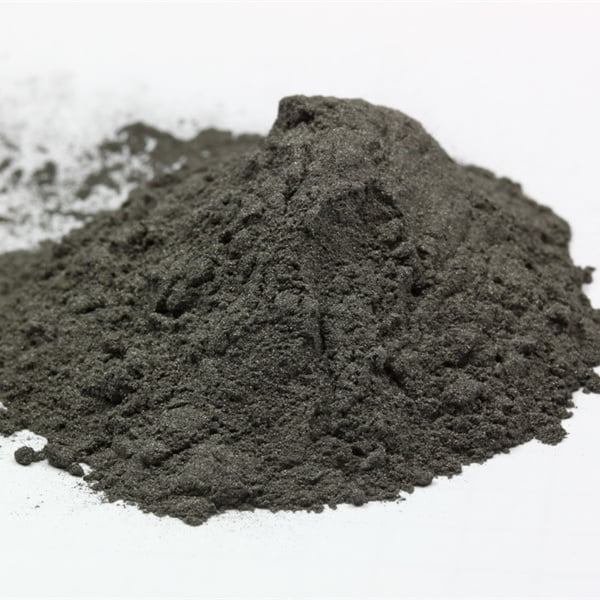
자주 묻는 질문
Q: 티타늄 알루미나이드 분말과 벌크 형태를 사용하는 산업은 무엇인가요?
A: 미세 분말 형태는 복잡한 항공우주 및 자동차 부품을 제작하는 적층 제조에 특히 적합합니다. 벌크 형태는 잉곳 야금에 활용됩니다.
Q: 적층 제조된 티타늄 알루미나이드 부품에는 어떤 후처리가 사용되나요?
대부분의 적층 제조 부품은 완전한 밀도 통합과 최적의 미세 구조를 달성하기 위해 열간 등방성 프레스(HIP) 및 열처리가 필요합니다. 그런 다음 최소한의 가공이 수행됩니다.
Q: 사용하지 않은 티타늄 알루미나이드 분말은 밀봉된 상태로 얼마나 오래 보관할 수 있나요?
A: 티타늄 알루미나이드 분말은 불활성 환경에 적절히 보관하면 심각한 산화 및 분해로 인해 흐름이나 성능에 영향을 미치기 전까지 12~24개월 동안 지속됩니다.
Q: 티타늄 알루미나이드를 개선하기 위한 연구 분야에는 어떤 것이 있나요?
A: 3D 프린팅 기술을 위한 응고 역학 모델링, 대체 생산 방법을 통한 재료 비용 절감, 상온 연성 향상을 위한 노력이 계속되고 있습니다.
공유
중국 칭다오에 본사를 둔 선도적인 적층 제조 솔루션 제공업체인 MET3DP Technology Co. 당사는 산업용 3D 프린팅 장비와 고성능 금속 분말을 전문으로 합니다.
관련 기사
Met3DP 소개
최근 업데이트
제품

3D 프린팅 및 적층 제조용 금속 분말
문의 정보
- 칭다오시, 산둥성, 중국
- [email protected]
- [email protected]
- +86 19116340731







